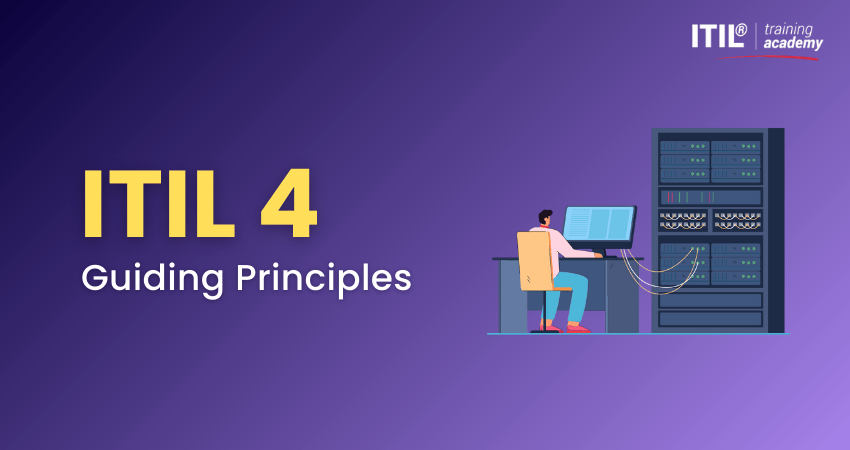
Author-David Walter
Last updated-Jun 10, 2025
Keeping an organisation's IT services running like clockwork takes the top spot in the priority hierarchy in this day and age. After all, IT has evolved from being a mere support system to being the backbone of business success. So, how do top companies manage their IT services so smoothly? The answer lies in the Information Technology Infrastructure Library (ITIL®), a globally recognised framework that brings structure, clarity and value to IT Service Management.
If you are thinking of turbocharging your organisation’s IT services, this blog will help you out by exploring What is ITIL®. This blog will spotlight its core principles, benefits, and how it can drive better results for both teams and customers. So read on and achieve everything from boosting efficiency to aligning tech with strategy!
Table of Content
1) What is ITIL®?
2) History of ITIL®
3) What is the ITIL® Framework?
4) What are the ITIL® Concepts?
5) What are the Guiding Principles of ITIL®?
6) ITIL® Functions
7) Benefits of ITIL®
8) Drawbacks of ITIL®
9) How Does ITIL® Help Business?
10) How can You put ITIL® Into Practice?
11) Conclusion
What is ITIL®?
ITIL®, which stands for Information Technology Infrastructure Library, is a widely recognised framework for managing IT services. It offers best practices and clear guidelines to help organisations ensure their IT services align with their business goals. ITIL® focuses on providing value to customers by managing the full-service lifecycle: planning, designing, running, and improving services.
ITIL® isn’t just for IT teams; it helps IT and business units work better together to meet overall goals. Its clear, step-by-step approach supports smarter decisions, quicker problem-solving, and more dependable services. Whether you're running a help desk, launching new software, or improving systems, ITIL® gives you the tools to do it right.
History of ITIL®
ITIL® has evolved significantly since its inception in the 1980s. Each new version has added better ideas and updated practices to make managing IT services more effective and in line with modern needs. Here’s a brief history of ITIL®:
What is the ITIL® Framework?
ITIL® has improved a lot over time. With each new version building on the last, it has grown into a widely used and trusted standard for IT Service Management. Today, the latest version is ITIL® 4, but looking at the earlier versions helps us understand how ITIL® has developed and improved.
ITIL® V1
The first version was developed by the UK’s CCTA to standardise IT practices in the 1980s. It comprises over 30 volumes with detailed guidance on Service Management, including change control, help desk, contingency, and technical infrastructure
ITIL® V2
This version consolidated the large number of ITIL® 1 volumes into core libraries (Service Support & Service Delivery). This was developed in and around 2000. It improved the clarity and practical usability for businesses, leading to wide adoption across industries.
ITIL® V3
This version was developed in 2007 and introduced the IT Service Lifecycle model with five key stages:
a) Service Strategy
b) Service Design
c) Service Transition
d) Service Operation
e) Continual Service Improvement
This brought a more structured, holistic approach to ITSM aligned with business objectives.
ITIL® V4
This version, introduced in 2019, embraced a modern Service Value System (SVS) focused on delivering value. It transitioned from rigid processes to flexible practices by integrating methodologies such as Agile, DevOps, and Lean. It introduced a four-dimensional model covering organisations, technology, partners, and value streams.
What are the ITIL® Concepts?
ITIL® is built around best practices for managing IT services. A key idea is the service lifecycle, which includes stages like:
1) Strategy
2) Design
3) Transition
4) Operation
5) Ongoing improvement
It focuses on delivering true value by meeting customer needs and supporting business goals. ITIL® employs a process-based approach, with clear steps for handling incidents, resolving problems, and managing changes. It also highlights four key areas:
1) People and teams
2) Information and technology
3) Partners and suppliers
4) Flow of work through processes
What are the Guiding Principles of ITIL®?
The seven guiding principles of ITIL® help organisations apply ITIL® practices in a smart and flexible way. These are:
1) Focus on Value: Always consider what benefits the customer and ensure your work adds value to them.
2) Start Where You Are: Look at what you already have and use current tools and systems instead of starting from scratch.
3) Progress Iteratively with Feedback: Make changes in small steps and use feedback to continually improve without overcomplicating things.
4) Collaborate and Promote Visibility: Work closely with various teams and keep everyone informed about ongoing developments.
5) Think and Work Holistically: Look at the whole organisation and how everything connects not just individual parts.
6) Keep It Simple and Practical: Always avoid overcomplicating things. Do what’s necessary and useful to get results.
7) Optimise and Automate: Make your processes better and more efficient. Utilise automation to streamline manual tasks and enhance consistency.
Master the Modern Language of IT! Begin with our comprehensive ITIL® 4 Foundation Training - Sign up now!
ITIL® Functions
ITIL® functions include the following five major functions. Let’s explore them in detail:
Event Management
Event Management involves monitoring all activities within the IT system. It helps spot issues early by sorting events into types like informational, warning, or error. This way, the team can respond to problems quickly and keep IT services running smoothly and without major interruptions.
Incident Management
Incident Management focuses on restoring normal service operations as quickly as possible following a disruption. It includes logging, categorising, and resolving incidents to minimise their impact on business activities as much as possible. The primary goal is to ensure a fast recovery, keeping users productive and satisfied.
Request Fulfilment
Request fulfilment takes care of everyday service requests like resetting passwords, installing software, or giving access to systems. These aren’t urgent problems, just regular user needs. By handling them quickly and smoothly, IT teams make things easier for users and help improve overall service quality.
Access Management
Access Management helps you make sure that only authorised users can access specific data or systems. It involves granting, restricting, or revoking user access based on organisational policies. This function protects sensitive information and supports the overall security of IT services.
Problem Management
Problem Management is about identifying and resolving the primary causes of recurring issues. It includes reacting to known problems and taking steps to prevent new ones. The goal is to reduce the number of future incidents and improve the stability and reliability of IT services.
Benefits of ITIL®
There are several benefits of employing ITIL® in business practices. Let’s explore the main pros:
1) Providing Better Services:
a) ITIL® helps businesses provide better-quality IT services.
b) It offers clear guidelines for managing IT processes.
c) These practices ensure consistency and reliability in service delivery.
d) By using ITIL®, companies can respond to customer needs more effectively.
e) This leads to improved trust and customer satisfaction.
2) Delivering Superior Support:
a) ITIL® enhances how IT support teams manage issues and requests.
b) It provides a structured approach to addressing incidents and problems.
c) This results in faster issue resolution and reduced downtime.
d) Users receive more efficient and reliable support.
e) Overall, it improves the quality of IT service delivery.
3) Enabling Business Change:
a) ITIL® helps organisations handle change more effectively.
b) It provides clear frameworks for managing and rolling out new IT services or updates.
c) Changes are planned and implemented with minimal disruption.
d) It ensures smoother transitions during system or process updates.
e) Supports business growth and innovation by making change easier to manage.
Drawbacks of ITIL®
1) Complexity and Resource Demands:
a) ITIL®’s framework is highly detailed, which can feel overwhelming.
b) Smaller organisations may struggle with its complexity.
c) Implementation demands a lot of time, funding, and effort.
d) Resources are needed for training staff, buying tools, and managing documentation.
e) Overall, it can be costly and resource-intensive to adopt.
2) Limited Flexibility and Slow Updates:
a) ITIL®’s structured nature can limit flexibility and adaptability.
b) It may slow down responses to rapid changes in technology or business needs.
c) The framework can feel rigid in fast-moving environments.
d) Updates to ITIL® are often slow to roll out.
e) This can cause ITIL® to fall behind emerging technologies and industry trends.
3) Cultural and Organisational Challenges:
a) ITIL® adoption often requires a shift in workplace culture.
b) Internal teams may resist these cultural changes.
c) The framework’s strong focus on processes can overshadow human factors.
d) It may overlook the importance of teamwork and collaboration.
e) Broader organisational dynamics might not be fully addressed.
4) Customisation and Bureaucracy Issues:
a) Customising ITIL® to suit specific business needs can be challenging.
b) The framework’s rigid structure may not easily fit all organisations.
c) ITIL® places heavy emphasis on documentation and formal processes.
d) If not managed well, this can lead to unnecessary bureaucracy.
e) Excessive paperwork may slow down workflows and reduce efficiency.
How does ITIL® Help Business?
ITIL® helps businesses by making sure IT services support their main goals. It improves how services are delivered and keeps customers happier. With clear processes and best practices, ITIL® reduces downtime, better handles risks, and enables teams to respond quickly to changes.
It also improves teamwork between IT and other departments, resulting in a more efficient use of resources and lower costs. In the long run, ITIL® turns IT into a key part of business growth and innovation.
How can You put ITIL® Into Practice?
ITIL® can be confusing at first and even harder to use correctly. But following a few best practices can make things easier:
Understand the Purpose: Know why you're using ITIL®. Business leaders should have clear reasons and understand how it will help the organisation.
Gain Expertise: ITIL® needs special skills. It’s not something you can learn overnight. Ensure your team includes individuals with ITIL® certification or relevant experience. You might need to provide training or hire experts.
Start Small: Try out one or two ITIL® practices first. Use case studies to guide you. Note how things work before and after the change to see improvements. If it works well, slowly introduce more practices based on what you learn.
Focus on Results: ITIL® is a tool to help you achieve your goals, such as improved service or reduced costs. Set clear goals and track your results with simple metrics to see if ITIL® is helping.
Conclusion
ITIL® is the ultimate roadmap to better IT service delivery. By understanding What is ITIL®, its core principles and practices, even beginners can start building more efficient, reliable, and customer-focused IT systems. Whether you're aiming to improve support or align IT with business goals, ITIL® offers the tools to turn those goals into reality.
Most Recent
Date - Sep 20, 2025
Date - Sep 20, 2025
Date - Sep 20, 2025





 Back to
Topics
Back to
Topics


























